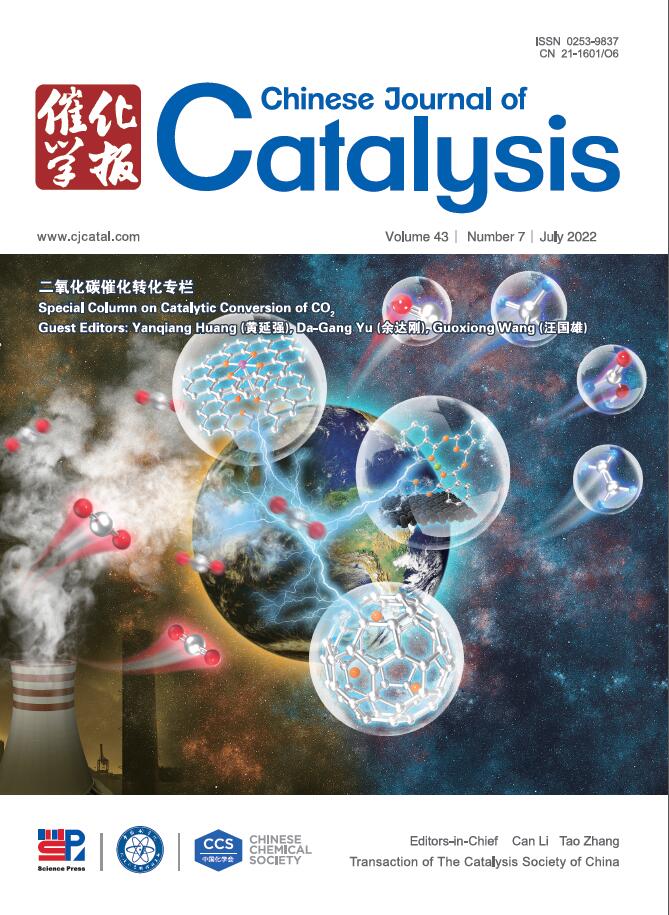Tuning d-band electronic structure of Ni-Fe oxyhydroxides via doping engineering boosts seawater oxidation performance
IF 15.7
1区 化学
Q1 CHEMISTRY, APPLIED
引用次数: 0
Abstract
Seawater electrolysis holds significant importance for advancing clean energy conversion. NiFe-based catalysts exhibit outstanding performance in the oxygen evolution reaction (OER) under alkaline conditions. However, the instability of the Fe active center leads to leakage issues, hindering further development in the field of seawater electrolysis. Here, we adopt an element doping engineering strategy to enhance the OER activity of Ni-Fe oxyhydroxides and greatly stabilize the Fe sites by meticulously optimizing the d-band centers. Among the selected metals (Al, Ce, Co, Cr, Cu, Mn, Sn, Zn and Zr), Mn doping is the most effective as confirmed by both theoretical calculations and experimental verifications. The NiFeMn-OOH/NF formed in situ from the corresponding metal-organic framework requires only 217 mV to achieve a current density of 10 mA·cm–2 in alkaline seawater, and exhibits exceptional stability. Theoretical calculations uncover that the Fe sites exhibit better balance of adsorption-desorption kinetics for OER intermediates than Ni sites and Ni-Fe dual-sites, while Mn sites with the polyvalent nature modulate the d-band center closer to Fermi level, facilitate the transfer of electrons across the catalyst surface, thus accelerating the reaction kinetics. This work is of considerable significance for achieving efficient and sustainable seawater electrolysis.
通过掺杂工程调整Ni-Fe氧化氢氧化物的d波段电子结构,提高海水氧化性能
海水电解对推进清洁能源转换具有重要意义。镍铁基催化剂在碱性条件下的氧进化反应(OER)中表现出卓越的性能。然而,铁活性中心的不稳定性导致了泄漏问题,阻碍了海水电解领域的进一步发展。在此,我们采用元素掺杂工程策略来提高镍铁氧体氢氧化物的 OER 活性,并通过精心优化 d 带中心来极大地稳定铁的位点。经理论计算和实验验证,在所选金属(Al、Ce、Co、Cr、Cu、Mn、Sn、Zn 和 Zr)中,掺杂 Mn 的效果最好。由相应的金属有机框架就地形成的 NiFeMn-OOH/NF 只需要 217 mV 就能在碱性海水中达到 10 mA-cm-2 的电流密度,并表现出超强的稳定性。理论计算发现,与镍位点和镍铁双位点相比,铁位点在 OER 中间体的吸附-解吸动力学方面表现出更好的平衡,而具有多价性质的锰位点可调节 d 带中心,使其更接近费米级,促进电子在催化剂表面的转移,从而加速反应动力学。这项工作对于实现高效、可持续的海水电解具有重要意义。
本文章由计算机程序翻译,如有差异,请以英文原文为准。
求助全文
约1分钟内获得全文
求助全文
来源期刊

Chinese Journal of Catalysis
工程技术-工程:化工
CiteScore
25.80
自引率
10.30%
发文量
235
审稿时长
1.2 months
期刊介绍:
The journal covers a broad scope, encompassing new trends in catalysis for applications in energy production, environmental protection, and the preparation of materials, petroleum chemicals, and fine chemicals. It explores the scientific foundation for preparing and activating catalysts of commercial interest, emphasizing representative models.The focus includes spectroscopic methods for structural characterization, especially in situ techniques, as well as new theoretical methods with practical impact in catalysis and catalytic reactions.The journal delves into the relationship between homogeneous and heterogeneous catalysis and includes theoretical studies on the structure and reactivity of catalysts.Additionally, contributions on photocatalysis, biocatalysis, surface science, and catalysis-related chemical kinetics are welcomed.
 求助内容:
求助内容: 应助结果提醒方式:
应助结果提醒方式:


